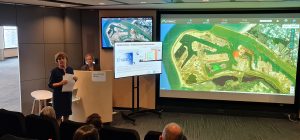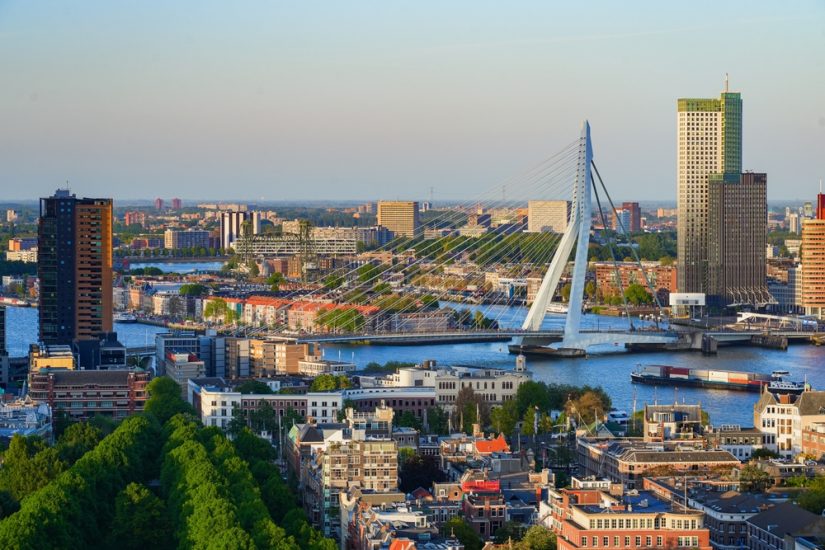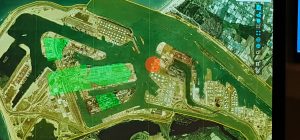By Phillip Butterworth-Hayes
Europe’s most advanced U-space management system is being developed to manage increasingly complex drone operations at Rotterdam Port.
The pre-operational prototype was developed at the start of the year and has slowly been adding services so that a fully functioning operational UAS traffic management (UTM) system is now ready to manage drone operations from over 40 operators flying drones in the port (See: How the Rotterdam Port prototype U-space system works).
Unmanned Airspace attended a demonstration of the system in November this year.
According to Ingrid Römers, Senior Advisor at the Port of Rotterdam Authority: “We want to learn about U-space and to define our role exactly; we want to drive innovation and be able to have counter measures in place if necessary. There are more complex drone operations coming soon, including eVTOLs, and we want to be prepared for that future.”
The current system is hosted in the Port Authority building and six airspace managers have been trained to use the equipment. The basic system is now operational and over the next few weeks will be adding some important new functions – replacing the current manual flight authorisation requests with a faster digital interface, enhancing the dynamic airspace integration function and connecting to the crewed air traffic management system, among other elements.
“The next step will be to add more data layers,” said Ingrid Römers, “such as ship positions, extended pre-flight and in-flight services, a weather application and a radar system which will allow us to integrate digital manned aviation and start assessing airspace risk. Once we have all flights in one system, manned and unmanned, and electronically visible we can develop risk mitigating measures for operators – this includes assessing what kind of procedures operators have in place to manage a fly-away situation.”
The key motivation to develop the system has been to improve safety at the port; since its inception the port has also become aware of the relatively large number of drone operators working and where they are operating. This information has proved particularly valuable for police, port security and customs agencies. It is not just the number of drone operations which has proved surprising but the different types of flight profiles; the port authority acknowledges that not all drones flying at the port will need UTM services.
“Some drone operators will prefer a more manual type of operation whereas others want a digitized process,” Ingrid Römers. “We will want to manage them all. We are anticipating more complex operations such as delivery flights flying beyond visual line of sight (BVLOS), all sharing the same airspace.”
“The project was launched in January and we have been prototyping various solutions which will be deployed in the next few days,” said Eyal Zor, Co Founder and CEO of Airwayz, which developed the core technology.
The drone flight control system is directly connected to the UTM system, via cellular, Wi-Fi or even satellite links in the future if and when latency problems can be overcome. The system constantly analyses connectivity performance and alerts the airspace manager if a link is downgraded or lost. The system requires a relatively small number of data set – altitude, position coordinates, power usage and connectivity status – but as connectivity performance will be a key part of the certification process this area has been a focus of engineering work so far.
“We will add out own conformance monitoring in the future,” said Eyal Zor. “The key issue is stability. Cellular coverage works very well in the Netherlands, but operators could contact their mobile network operator (MNO) and ask for coverage upgrade if it is required.”

Ingrid Römers: We are anticipating more complex operations such as delivery flights flying beyond visual line of sight (BVLOS), all sharing the same airspace
“In terms of conformance monitoring – each drone is connected to the UTM system which downloads telemetry information so if the drone strays from its permitted area of operation a message is sent to the UTM system which is then relayed to the pilot,” said Eyal Zor.
There is a long way still to go before the system can be officially certified as U-space management system, ready to handle multiple autonomous drone operations to the regulatory requirements laid down by the European Aviation Safety Agency. The hardware and U-space service provider (USSP) functions are entirely integrated and there is no plan yet for who the USSP might be – and when such a role will be certified by the national aviation safety regulator. There is only one BVLOS operation in the port monitored by the system, currently limited to 2km operations, though with plans to expand in the future.
But even in its embryonic stage, the Rotterdam port U-space management system will allow drone operators the opportunity to expand their operations and add new services – effectively building a road on which more advanced services can start to evolve.
“This is what U-space should look like once the regulations are in place,” said Ingrid Römers.
| How the Rotterdam Port prototype U-space system works
The current system features the following functions: · Flight authorisation · Geo awareness · Tracking and monitoring · Conflict detection and resolution · Conformance monitoring · Dynamic airspace reconfiguration The UTM system connects directly to the drone operator’s command and control network, server to server. The system has been designed and developed by Airwayz and the system interface is via APIs or a Web App – the system does not discriminate against either type of user and authorisations are selected on a first-come first-serve basis, unless a high priority service flight is suddenly planned. Aeret has integrated the flight authorization process for area zones and SkyOps has completed the integration and is providing real-time positions and managing all the services and alerts.
The airspace manager has allocated area and time reservations for drone operators in green. The no-fly zone is in red. The drone operator submits a flight request for a space and time reservation, which the airspace manager marks as a future flight. Time and flight reservations are mapped on a large digital display of the port. In case of a conflicting flight authorisation request the Web App Operator DDC rejects the flight and offers and alternative area/time which does not overlap are asks for another submission. The API then submits an area authorization request for immediate takeoff and the UTM system checks and approves the request. In case of a conflicting request the airspace manager gets an alert, sends a rejection and offers the drone operator a choice between adjusting the flight are or changing the flight time. Once the authorisation has been given the operator submits a trajectory request for immediate take off and the UTM system checks and approves the request. According to a Port of Rotterdam White paper from Ingrid Römers: “The prototype will offer the Port of Rotterdam Authority the opportunity to assess what is needed to organise safe airspace and to build up a knowledge of U-space. It will help to decide whether we would like to have a role in low altitude airspace in the future and what that role should be. The prototype is a collaborative partnership between the authorities, the municipality of Rotterdam, stakeholders, knowledge institutes such as the NLR and industry, and will help advance the many drone applications in the port from a neutral position. The port can play a leading role in this because thanks to all the water, the risks involved are lower than they would be over cities.” Source: https://www.portofrotterdam.com/sites/default/files/2022-03/drone-port-of-rotterdam-uspace-airspace-prototype-en.pdf |
(Image: Shutterstock)





